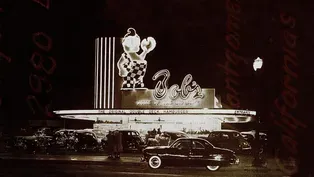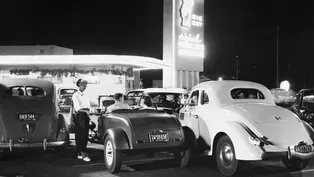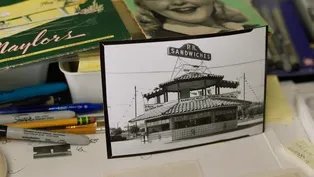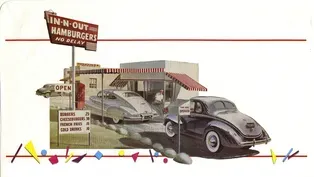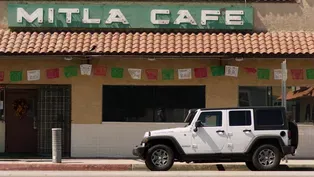
How McDonald's Revolutionized Fast Food Burgers
Clip: Season 6 Episode 1 | 5m 4sVideo has Closed Captions
McDonald's evolved from a car-hop drive-in in San Bernardino to a global fast food giant.
The lesser-known history of the McDonald's fast food chain is how it got its start with the McDonald brothers at a stand in San Bernardino, California — and how their Speedee Service System offered burgers that weren't just fast and cheap, but also good.
Problems with Closed Captions? Closed Captioning Feedback
Problems with Closed Captions? Closed Captioning Feedback
Lost LA is a local public television program presented by PBS SoCal

How McDonald's Revolutionized Fast Food Burgers
Clip: Season 6 Episode 1 | 5m 4sVideo has Closed Captions
The lesser-known history of the McDonald's fast food chain is how it got its start with the McDonald brothers at a stand in San Bernardino, California — and how their Speedee Service System offered burgers that weren't just fast and cheap, but also good.
Problems with Closed Captions? Closed Captioning Feedback
How to Watch Lost LA
Lost LA is available to stream on pbs.org and the free PBS App, available on iPhone, Apple TV, Android TV, Android smartphones, Amazon Fire TV, Amazon Fire Tablet, Roku, Samsung Smart TV, and Vizio.
Providing Support for PBS.org
Learn Moreabout PBS online sponsorship' Bob's Big Boy, the blueprint for modern fast food began to unfold.
Out in San Bernardino, the McDonald brothers ran a similar operation--a drive-in barbecue joint along bustling Route 66.
Their burgers sizzled with popularity, yet they noticed a bottleneck.
Teens drawn by the carhops and ample parking made it their evening rendezvous, slowing down sales.
This spurred a revolutionary idea.
In 1948, the brothers closed their drive-in for a transformative renovation.
On reopening, a fresh concept emerged.
Carhops were history, replaced by a walk-up window, fast service, low prices, and no tipping.
The menu, now streamlined, spotlighted one star-- the hamburger.
A gamble?
Absolutely.
But for Dick and Mac McDonald, it paid off.
McDonald's as we know it was born.
While the original location was demolished in the seventies, an early McDonald's franchise built in 1953 survives in Downey, at Lakewood and Florence.
I caught up there with author and journalist Chris Nichols, who helped save this iconic Googie structure in the nineties.
Can I get you some lunch?
Nichols: Yeah.
OK. Can I get the original cheeseburger, please?
Masters: I'll have a Big Mac.
Now, when you walk up, one of the things that you notice is there are no tables or chairs here.
There's no place to sit down and eat.
Nichols: No, and there never was.
This was developed so that you come up, get your food, and you're outta here.
Masters: What's interesting is you look at the double arches there, the M, I mean, you see the roof in that, right?
Nichols: Yeah.
That's the two arches and the roofline creating the original logo, which became the M, which they're still using to this day.
Masters: That's a logo people will recognize anywhere in the world.
Nichols: For sure, for sure.
Masters: And it started right here.
Nichols: Based on L.A. architecture architecture.
Masters: Wow.
What's so special about this McDonald's?
Nichols: It is the last of its kind.
It's the oldest McDonald's in the world.
It's a great piece of architecture, it's colorful, and you can get a hamburger here.
Master: I don't know about you, but it's always grated on me a little bit that Southern California is--is always a little undersold in the official corporate history of McDonald's.
Nichols: The L.A. story is that the McDonald brothers had 8 or 9 restaurants and they had a person in L.A. that was selling franchises, but he wasn't very good.
Kroc took it and it caught fire.
He had the energy and the money and the ability and the drive to build this huge corporation.
Masters: What was McDonald's like before Ray Kroc?
Nichols: Well, they had moved, physically moved, their little drive-in from Monrovia out to San Bernardino and reopened it as a very traditional 1930s-style carhop drive-in.
And then in 1948, they had this epiphany that they should fire all the waitresses, shut the place down, and start over again.
And that's when they came up with what they called the Speedee Service system.
Their idea of how to make hamburgers fast and cheap and good.
It was a totally new way of doing hot food ready when you are.
There were all kinds of innovations that these guys came up with.
There was a strange device that squirts the ketchup and mustard perfectly on the burger.
There's an extra-long spatula.
There are all these technical innovations that made their Speedee Service system, which is what this is all built on, possible, and they were all handcrafted out in San Bernardino.
So, it's a great story of innovation, of technology, and it became hugely successful, like overnight.
There were lines of people coming.
There were truck drivers and kids and families, and it was super cheap, even at the time.
It was an instant hit, and that's how Kroc found out about it.
Masters: So, sometimes, it seems like everything wacky and eye-catching that makes L.A. so distinctive is always at risk of disappearing.
Nichols: I hold these truths to be self-evident, that these buildings are important and special and artful and deserve protection.
For me as an architecture lover, I want to see the building, you know?
I want to experience it, and if I can experience 1953 in full color and 3 dimensions, like I can here, oh, my God, I'm ecstatic.
All the planes, all the red and white tile and the canted windows, it's animated and in motion and exciting.
It's a crazy symphony of shapes and colors.
Masters: You'll never get tired of looking at it.
Nichols: Right?
And I don't.
I love it so much.
Masters: What did it take to save this place?
Nichols: Right around the time the conservancy was fighting to save the Downey McDonald's, they were also fighting to save the cathedral in downtown.
And so, they were fighting the Catholic Church and the McDonald's Corporation at the same time.
Masters: Two of the world's most powerful institutions.
Nichols: And it was a huge effort.
In this particular case, there was pushback, because McDonald's whole schtick is that they're standardized.
Everything works the same.
You get the same food.
The same equipment.
The buildings look the same.
And this has none of those.
But they finally came around to seeing that the benefit outweighed the cost.
This little museum is, is pretty great.
Masters: Hello.
[Laughs] Nichols: Every fast-food place is now a behemoth.
But this was Dick and Mac McDonald.
These were real people and small businesspeople and they were trying to be innovative and trying to come up with something that hadn't been done before and new takes on things, and they really invented a new lifestyle, for better or worse, that came out of L.A.
Fast Food and Car Culture (Preview)
Video has Closed Captions
Iconic fast-food chains from McDonald’s to Taco Bell were born in SoCal. (30s)
Double Burgers and Classic Cars at Bob's Big Boy
Video has Closed Captions
Double hamburgers, Googie architecture and classic cars at Bob's Big Boy in Burbank, CA. (3m 31s)
Roadside Architecture Evolved With Car Culture
Video has Closed Captions
Attention-grabbing, eye-catching designs turned architecture into roadside advertising. (3m 21s)
Video has Closed Captions
In-N-Out's first burger stand on Route 66 may have given birth to today's drive-thru. (5m 22s)
Taco Bell's Fast Food Origin Story
Video has Closed Captions
Taco Bell and Del Taco can trace their fast food origins to Mitla Café in San Bernardino. (5m 52s)
Providing Support for PBS.org
Learn Moreabout PBS online sponsorshipLost LA is a local public television program presented by PBS SoCal
